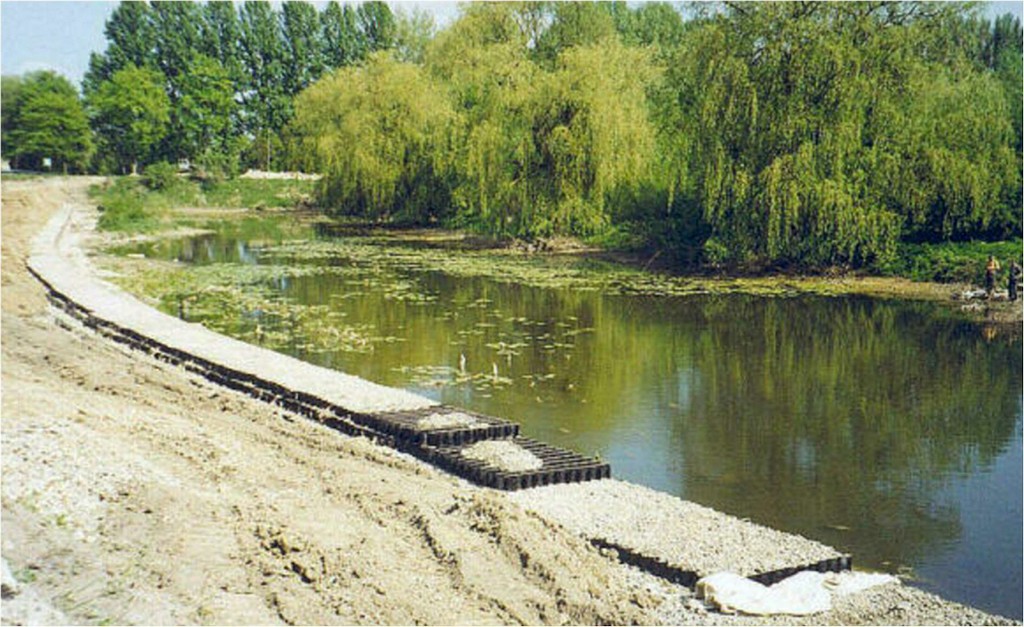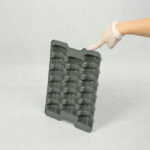When the groundwater and emotions have subsided, it is worth asking a key question: Have we learned the right lessons from 1997, 2010 and the recent dramatic events of a few months ago?
It is a fact that Poland is increasingly facing the problem of flooding. Unfortunately, despite the painful experience of the past, many dikes still do not meet adequate standards of protection. Experts' predictions do not inspire optimism either - we need to be ready for more floods, which could again bring tragic consequences.
So what can be done to effectively prevent possible tragedies in the future? There are several ways to protect against flooding rivers. In this article, we will focus on one of the most effective solutions, that is, reinforcing dikes with cellular geonets.
In this article you will find answers to such questions and others:
- Geomaxx® - an economical and simple way to reinforce embankment slopes
- Let's turn the question around - why have so many dikes proven to be ineffective?
- What is the installation of cellular geo-grid when securing a slope?
- The main benefits of using Geomaxx®
- Effective flood protection - will we learn lessons for the future?
Geomaxx® - an economical and simple way to reinforce embankment slopes
Geomaxx® is a solution that has proven itself for years in road construction. We can also use it to reinforce embankment slopes. Its main advantage? The ability to stop soil erosion, which significantly increases the resistance of slopes to the destructive effects of the elements. This is extremely important, because as the recent events of a few months ago showed - even the already existing embankments could not withstand the onslaught of great water. But how does this system work and why is it so effective?
Let's turn the question around - why have so many dikes proven to be ineffective?
Well, the construction of the embankment body itself is carried out according to accepted standards, and when constructing the embankment it is necessary to take into account such factors as the location, the method of compaction of the various layers, as well as the type of embankment material (whether it is aggregate or perhaps embankment soil supplied from elsewhere). It is worth noting at this point that any embankment made with the highest engineering skill will prove useless if its slopes will not be resistant to being washed up by flowing water. The cellular geo-grid forms a network of cells, which are then filled with backfill material - aggregate, soil and, in some cases, concrete mix. This is what gives the embankment additional stability and protects the slope from sliding, preventing cracking or leaching of the embankment structure. It is for this reason that Geomaxx® cellular geonets provide effective (and also economical) protection against flooding.
What is the installation of cellular geo-grid when securing a slope?
Installation of the cellular geo-grid is very simple and involves several steps:
- Preparation of the development site.
Before installing the cellular geonet, it is important to thoroughly clean the slope of vegetation and form the soil that will become the base for the geonet. To ensure the stability of the embankment, the first step is to thoroughly clean the slope. Any vegetation is removed, and then the area is properly formed to facilitate further installation. Finally, an anchor trench is created along the crest and edge of the slope to reinforce the structure, creating a solid base for the installation of the geo-grid.
- Spreading the separation layer of geotextiles
In areas that require it, a special layer of geotextile is spread, which acts as a separation between the slope and the geo-grid. This provides adequate filtration and additional protection against erosion. The sheets are laid in such a way that their edges are protected from shifting, which strengthens the stability of the entire structure.
- Installation of cellular geo-grid sections
The cellular geonet is loosely placed on the slope, then stretched to full cell size and connected to the adjacent section. The key elements of this step are anchors of the appropriate length and diameter and tension cables. A properly composed system of geo-grid and mounting accessories ensures the strength of the structure even during extreme weather conditions. Anchor pins, are distributed both on the crown of the slope (anchoring in each cell) and throughout the slope (anchoring every 4th cell vertically and every 2nd cell horizontally). This ensures the strength of the structure even during intense weather conditions. The individual sections are connected by ties, creating a consistent and flexible protection.
- Filling of geo-grid cells
Geomaxx® geo-grid allows various methods of filling, depending on local needs and characteristics of the site. It can be filled with soil, aggregate, concrete, or even covered with vegetation. The material is evenly backfilled, starting from the bottom to the top of the slope to ensure stability and prevent shifting. Thanks to its special design, the geo-grid reduces erosion and protects the slope from sliding material.
- Final finishing of the installation
Once all the work is completed, the flood barrier is ready to , effectively protecting the area from water. Filled cells, especially those covered with vegetation, give the entire structure a natural and aesthetically pleasing appearance, while enhancing its functionality and resistance to damage. Additional layers of anti-erosion mats can be applied to more difficult areas, while ensuring the full safety and durability of the slope.s of the industry, providing products that combine durability, lightness and ecology. Plastic? By all means they can be eco!
The main benefits of using Geomaxx®
The benefits of applications of cellular geonets Geomaxx® for dike reinforcement are multidimensional and include, but are not limited to:
- Reduction of erosion.
Soil-filled cell walls form natural mini-barriers on slopes that effectively impede the flow of water and reduce its erosive effect, minimizing the risk of gouges.
- Stabilization of soil and vegetation.
The geo-grid allows vegetation to grow freely, while stabilizing the soil. Plant roots further strengthen the soil, creating a consistent green protective layer over the entire surface.
- Effective moisture retention.
In dry regions, geo-grid cells contribute to moisture retention, which promotes vegetation growth and improves overall slope stability.
- Universal use of fillings.
Geomaxx® geonet can be filled with a variety of materials - from soil to aggregate to concrete. Each of these materials adapts to the specific terrain and provides the appropriate erosion protection as needed.
Effective flood protection - will we learn lessons for the future?
Despite a number of tragic experiences, such as the floods of 1997, 2010 and recent months, the problem of flood protection is still relevant. Each of these tragedies should motivate us to take measures to minimize the effects of future disasters. However, reality shows that systematic measures and safeguards are still lacking, despite widely available technologies such as Cellular geonets that effectively reinforce embankments and slopes.

Photo: The beginning of construction of the Sandomierz embankment in the vicinity of Krakowska Street (the photo shows the beginning of construction of the retaining wall for the flood control embankment).
Using the Sandomierz embankment as an example, one can see how effectively the use of cellular geo-grid protected the slopes from erosion. Dike withstood water pressure during floods, and vegetation covering the slope further improved the stability of the structure.
In the face of increasing risks, we must recognize that the one-time costs of adequate safeguards are lower than the expenses of flood recovery and support for those in need.
Follow us on social media
You may also be interested in:
- Thermoforming - process and applicationVacuum thermoforming is a technological process during which products of specific shapes are formed from flat plates fixed in special frames-heated to a certain temperature characteristic of a given thermoplastic material.Forming the desired shape is carried out when the plastic is in a highly elastic state. A vacuum is generated between the heated plate and the tool (mold), and under the influence of external pressure the deformation ...
- Geocell for Slopes – 5 cm, 10 cm, or 15 cm? Which One to Choose?Slope geogrids are an effective solution for many projects. It is not without reason that the most frequently selected are those with a height of 5, 10 and 15 centimeters. Choosing the right height of geogrid is not just a technical issue - it is the foundation for the success of the entire project. A properly selected Geomaxx® geogrid ensures not only the stability of the structure, but also its long-term functionality. Which option will ...
Geocell for Slopes – 5 cm, 10 cm, or 15 cm? Which One to Choose? Read More "
- Designing and making molds - production at Geo Globe PolandDesigning and making molds is a key stage in the vacuum thermoforming process. At Geo Globe Poland, we carry it out comprehensively - from concept, through 3D documentation, to the finished mold and production.
- Polymers and their importance: Discover the properties and applications of PET polyethylene terephthalate in various industriesProbably the abbreviation PET at the first moment makes you think of a plastic water bottle. However, you should know that polyethylene terephthalate is one of the most promising materials for business. It is lightweight, strong and resistant, plus it can be easily recycled.

















